Oxymercuration reduction - Study guides, Class notes & Summaries
Looking for the best study guides, study notes and summaries about Oxymercuration reduction? On this page you'll find 15 study documents about Oxymercuration reduction.
All 15 results
Sort by
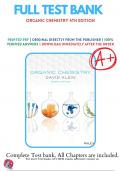
-
Test Bank for Organic Chemistry, 4th Edition by David R. Klein | 9781119659594|Chapter 1-27 | All Chapters with Answers and Rationals
- Exam (elaborations) • 2151 pages • 2023
- Available in package deal
-
- $24.14
- 28x sold
- + learn more
Test Bank for Organic Chemistry 4e 4th Edition by David R. Klein. ISBN-13: 9594 Full chapters test bank PDF TABLE OF CONTENTS 1 A Review of General Chemistry: Electrons, Bonds, and Molecular Properties 1 1.1 Introduction to Organic Chemistry 2 1.2 The Structural Theory of Matter 3 1.3 Electrons, Bonds, and Lewis Structures 4 1.4 Identifying Formal Charges 7 1.5 Induction and Polar Covalent Bonds 8 1.6 Reading Bond-Line Structures 11 1.7 Atomic Orbitals 14 1.8 Valence Bond Theory 17 1.9 Molecular...
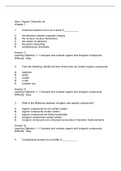
-
Test Bank for Organic Chemistry, 4th Edition by David R. Klein
- Exam (elaborations) • 2149 pages • 2022
-
- $29.99
- 82x sold
- + learn more
Test Bank for Organic Chemistry 4e 4th Edition by David R. Klein. ISBN-13: 9594 Full chapters test bank PDF TABLE OF CONTENTS 1 A Review of General Chemistry: Electrons, Bonds, and Molecular Properties 1 1.1 Introduction to Organic Chemistry 2 1.2 The Structural Theory of Matter 3 1.3 Electrons, Bonds, and Lewis Structures 4 1.4 Identifying Formal Charges 7 1.5 Induction and Polar Covalent Bonds 8 1.6 Reading Bond-Line Structures 11 1.7 Atomic Orbitals 14 1.8 Vale...
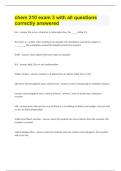
-
chem 210 exam 3 with all questions correctly answered
- Exam (elaborations) • 5 pages • 2023
-
Available in package deal
-
- $13.49
- + learn more
less the more s character a carbocation has, the _____stable it is the same as when looking at an epoxide, the orientation around the oxygen is _________ the orientation around the double bond in the reactant BrOH when added with base makes an epoxide Br2 adds 2 Brs in anti conformation lindlar catalyst produces a Z alkene from an alkyne (adds 2 Hs in syn) add more electronegative atom, add pi bond 2 ways of producing an oxidation reaction remove e...
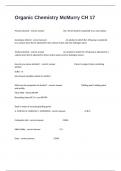
-
Organic Chemistry McMurry CH 17 Practice Exam Questions And Answers Guaranteed Pass.
- Exam (elaborations) • 6 pages • 2024
-
Available in package deal
-
- $12.99
- + learn more
Primary Alcohol - correct answer the -OH of alcohol is attached to an end carbon Secondary Alcohol - correct answer An alcohol in which the -OH group is attached to a carbon atom that is attached to two carbon chains and one hydrogen atom. Tertiary Alcohol - correct answer An alcohol in which the -OH group is attached to a carbon atom that is attached to three carbon atoms and no ...
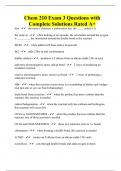
-
Chem 210 Exam 3 Questions with Complete Solutions Rated A+
- Exam (elaborations) • 4 pages • 2023
-
Available in package deal
-
- $11.99
- + learn more
less - the more s character a carbocation has, the _____stable it is the same as - when looking at an epoxide, the orientation around the oxygen is _________ the orientation around the double bond in the reactant BrOH - when added with base makes an epoxide Br2 - adds 2 Brs in anti conformation lindlar catalyst - produces a Z alkene from an alkyne (adds 2 Hs in syn) add more electronegative atom, add pi bond - 2 ways of producing an oxidation reaction remove e...
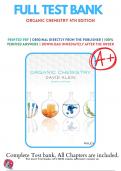
-
Test Bank for Organic Chemistry, 4th Edition by David R. Klein 9781119659594 | All Chapters with Answers and Rationals
- Exam (elaborations) • 2151 pages • 2023
- Available in package deal
-
- $22.81
- + learn more
Test Bank for Organic Chemistry 4e 4th Edition by David R. Klein. ISBN-13: 9594 Full chapters test bank PDF TABLE OF CONTENTS 1 A Review of General Chemistry: Electrons, Bonds, and Molecular Properties 1 1.1 Introduction to Organic Chemistry 2 1.2 The Structural Theory of Matter 3 1.3 Electrons, Bonds, and Lewis Structures 4 1.4 Identifying Formal Charges 7 1.5 Induction and Polar Covalent Bonds 8 1.6 Reading Bond-Line Structures 11 1.7 Atomic Orbitals 14 1.8 Valence Bond Theory 17 1.9 Molecular...
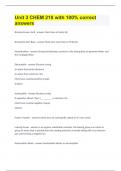
-
Unit 3 :CHEM 210 with 100% correct answers
- Exam (elaborations) • 4 pages • 2023
-
Available in package deal
-
- $13.99
- + learn more
Bronsted-Lowry Acid Must Have a Proton (H) Bronsted-Lowry Base Must have Lone Pairs or Pi Bonds Neutralization Strong Acid donates a proton to the Strong Base to generate Water and the Conjugate Base Electrophile Electron Loving An atom that wants electrons. An atom that is electron rich. Must have a partial positive charge. (Cation) Nucleophile Nucleus Loving If opposites attract, then a _________ is electron rich. Must have a partial negative charge. (An...
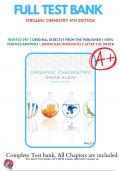
-
Test Bank for Organic Chemistry 4th Edition by David R. Klein | 9781119659594 |2021-2022 |Chapter 1-27 | All Chapters with Answers and Rationals
- Exam (elaborations) • 2151 pages • 2023
-
- $42.98
- + learn more
Test Bank for Organic Chemistry 4e 4th Edition by David R. Klein. ISBN-13: 9594 Full chapters test bank PDF TABLE OF CONTENTS 1 A Review of General Chemistry: Electrons, Bonds, and Molecular Properties 1 1.1 Introduction to Organic Chemistry 2 1.2 The Structural Theory of Matter 3 1.3 Electrons, Bonds, and Lewis Structures 4 1.4 Identifying Formal Charges 7 1.5 Induction and Polar Covalent Bonds 8 1.6 Reading Bond-Line Structures 11 1.7 Atomic Orbitals 14 1.8 Valence Bond Theory 17 1.9 Molecular...
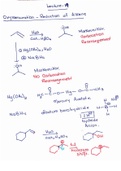
-
Oxymercuration-Reduction of Alkene Notes
- Class notes • 4 pages • 2023
- Available in package deal
-
- $4.49
- + learn more
Notes over oxymercuration-reduction of alkene and its mechcanism.
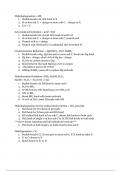
-
CHEM 220 alkene addition directions
- Class notes • 2 pages • 2024
-
- $7.99
- + learn more
This study guide covers the mechanisms and steps involved in several chemical reactions, including hydrohalogenation, acid-catalyzed hydration, oxymercuration-reduction, hydroboration-oxidation, hydrohalogenation by free radical chain reaction, dehalogenation, halohydrin formation, hydrogenation, ozonolysis, and halogenation. Each reaction is described through a series of numbered steps, detailing the formation of new bonds, the movement of electrons, and the addition or removal of functional gr...

How much did you already spend on Stuvia? Imagine there are plenty more of you out there paying for study notes, but this time YOU are the seller. Ka-ching! Discover all about earning on Stuvia


